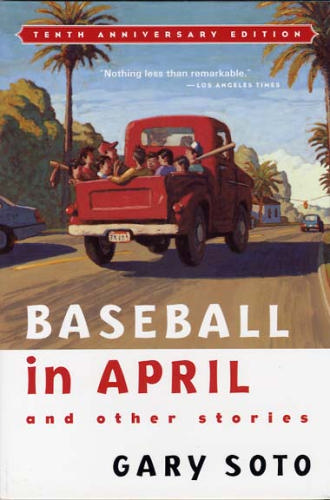
"Our shelves were not lined with books, they were lined with menudo (spicy Mexican soup)."[1]
In order to understand the influence of an urban setting on Gary Soto’s writing, we must first examine the impact that an urban environment had on Gary Soto’s life.
Gary Soto was born in Fresno, California on April 12th, 1952, to Manuel and Angie Soto.[2] His parents, like many other Mexican Americans, worked in San Joaquin Valley, the agricultural region surrounding Fresno. These jobs included picking crops such as oranges and cotton, or working in local businesses. Many of these jobs were very dangerous, and when Gary Soto was just five years old, his father Manuel was killed in an accident while working for the Sunmaid Raisin Company.[3] In later interviews, Soto claimed that this was one of the most devastating moments of his life.[4] With his mother Angie as the sole caretaker of Gary and his two siblings, his family was forced to move to a rough neighborhood, or Barrio, in the industrial sector of Fresno. Growing up in this area, Soto formed many of the experiences that would later be reflected in his work.
While living in Fresno, Angie Soto and her parents picked up odd jobs to sustain the family. Even this was not enough, and eventually Gary and his siblings began working in industrial and agricultural jobs. Gary’s job distracted from his studies, and soon Gary was pulling a D average in school. Although he may have spent more time chasing girls than studying, this period of Soto’s life was when he discovered the works of Hemmingway, Steinbeck, Vernes, and other prominent literary figures.[5] Soto went on to attend California State University, where he applied his passion in literature to receive a bachelor’s in English and a master’s in creative writing. Clearly, the educational disparity and poverty Soto felt while growing up in the Fresno barrio was not enough to stop him from engrossing himself in literature, setting himself up to be one of the greatest contemporary writers of our time.
"Of poetry or prose, I prefer poetry as part of my soul. I think like a poet, and behave like a poet."[6]
In his early years, Gary Soto focused primarily on writing poetry. After transferring to California State University, Soto began publishing his first poems. His first collection of poetry, The Elements of San Joaquin, described the hardships faced by Mexican Americans in central California. The book received many accolades, and began Soto’s career as a professional writer. His second collection, The Tale of the Sunlight, was nominated for the Pulitzer Prize.[7] These books and poems would be a preview of his later work, which would again draw upon his childhood experiences to paint a harsh but realistic picture of Mexican American life.[8]
"These are the pictures I take with me when I write. They stir up the past, the memories that are so vivid."[9]
Baseball in April marked the first time that Soto wrote a children’s book. According to his BookList biography, he began writing for children to “start Chicanos reading."[10] Published in 1990, a time when very little literature featured Latino youth, Baseball in April was one of the few children’s books that was written especially for the young Latino/Chicano demographic. Each of the eleven short stories in the book takes place in the barrios of central California, namely Fresno where Soto himself grew up. Through his narratives, he addresses many of the issues and concerns faced by impoverished young Latinos, such as education, money, and social status. In the following pages, Baseball in April will serve as a case study to view how Soto’s urban experiences in Fresno reflect into his writing style.
Some of the most obvious imprints of Soto’s life on Baseball are the constant references to his hometown of Fresno, California. Throughout the book, Soto references Fresno directly, rather than simply placing his characters in a general urban setting. For example, on page 23, Soto states:
“But now he lived in Fresno, on a shady street with quiet homes.”[11]
In contrast, he describes Mexico as having “dusty twilights, crickets, and the night sky studded with stars."[12] This contrasting depiction of Mexico and Soto’s hometown of Fresno reflects some of the negative experiences he had growing up there.
Secondly, Soto really places emphasis on the impact of a father figure on the characters. Although the concept of family has always traditionally been an important aspect of Latino culture, Soto especially places importance to the presence, or lack of presence, of a father:
“The kids knew he was good to them because many of them didn’t have fathers, or had fathers who were so beaten from hard work that they came home and fell asleep in front of the TV set.” [13]
“Do you know my father worked in the mines? That he nearly lost his life?” [14]
Clearly, the death of Soto’s father impacted him heavily, and this recurring theme carries on throughout the stories.
Additionally, even though Soto may not directly reference a father figure, he indirectly makes reference to his father and his profession. As mentioned before, his parents and grandparents worked at difficult agricultural jobs in San Joaquin Valley, where his father eventually was killed in an accident picking raisins. In his stories, many of the characters and their families also work in such positions:
“They talked about…the horrors of picking grapes in order to buy their fall clothes.” [15]
“Mrs. Moreno remembers her teenage years and her hardworking parents, who picked grapes and oranges…” [16]
Soto’s vivid memories of his parents and family’s backbreaking jobs stayed with him, and he translates these experiences and memories through the characters of his short stories.

One of the most prominent themes of Soto highlights in Baseball is his characters’ poverty. In just the third page of the book, he writes:
“She glared up at him. ‘Do you think money grows on trees?’ His mother clipped coupons from magazines and newspapers, kept a vegetable garden, and shopped at Penny’s and K-Mart.” [17]
By describing his characters’ poverty in such detail in the beginning, he sets a disparaging tone for the entire book. Even after this initial introduction, he refers to their poverty throughout:
“He cursed himself for being stupid, yelled at his bike for being cheap…” [18]
“He couldn’t just ask his parents because they would say ‘Money doesn’t grow on trees…'”[19]
Rather than just mentioning the characters’ poverty, many of the stories in the book actually revolve around the Latino families not having any money. In the story “No-Guitar Blues,” the little boy cannot buy a guitar due to his family’s financial situation. In “Mother and Daughter,” Yollie’s mother must dye her homecoming dress black so she has something to wear. Thus, Soto sets up “poverty” as the primary struggle against which his characters must face. These struggles seem to reflect his own childhood struggles, as him and his family had very little to live on as he was growing up in central California.
Although Soto sets up poverty as the main source of problems for his characters, he also writes about the apathy society shows his impoverished Latino characters. Many of these children tried to participate in “regular” activities, only to find themselves unable to do so because of the adults’ lack of interest:
“One day Manuel didn’t show up with his duffel bag. From that day, it was clear to the four boys who remained that the baseball season was over.” [20]
“Mr. Lopez had a faraway look in his eyes and seemed more interested in the people outside than his students.” [21]
Thus, Soto cites not only the children’s economic situation, but also the adults’ apathy for the reason why the children were unable to achieve their dreams. Again, Soto seems to draw upon his childhood experiences when making this commentary. In the interview mentioned above, he mentioned that he was never encouraged to study or participate in extracurriculars from the adults in his life. Similarly, many characters in his stories don’t receive any help from the adults, and are therefore unable to accomplish what they want.
Because of this societal apathy and low economic status faced by the characters in Soto’s stories, many of them dream of earning more money and moving up the social ladder. Some of Soto’s characters contemplate how to escape their situation:
“He wondered how they got so rich.” [22]
Other characters fantasize about living the high life:
“Not one day would pass without the butcher or barber…or ambitious children with dollar signs in their eyes waving to El Millonario.” [23]
“You wait son, you’ll be a rich man one of these days ."[24]
By emphasizing the importance his characters place on escaping the barrio, Soto indirectly cues the reader into his own history. Growing up, he and his parents had always dreamed that he would have a better future and that he would someday leave the barrios of Fresno to lead a better life. In this way, Soto’s own childhood dreams and aspirations are relayed through his characters, as they struggle and fantasize about leaving their impoverished situation.
Although most of the urban influences discussed above came with some overarching message, Soto also included many depictions of urban life simply as they were. That is, Soto drew from his everyday experiences growing up to pain colorful descriptions of day to day life in the barrio:
“Yollie’s mother, Mrs. Moreno, was a large woman who wore a muumuu and butterfly-shaped glasses. She liked to water her lawn in the evening and wave at low-riders, who would stare at her behind their smoky sunglasses and laugh.” [25]
Even in the casual depictions of the stories’ settings, Soto brings in his experiences to paint a vibrant scene of urban California.

Through the short stories presented in Baseball in April, and through his many other works of literature, Gary Soto reflects on his urban experiences growing up in Fresno. With some characters, he translates his struggles of living in the barrio, and with other characters, describes the hardships he faced when he lost his father. Although the characters may be very different from a young Gary Soto himself, he still manages to incorporate aspects of urban life into his stories. He includes these urban references not only in Baseball, but in almost all of his other works such as Accidental Love, Too Many Tamales, and Neighborhood Odes. Through these writings, Soto uses his urban surroundings to help directly shape and influence his literature.
“I do these things so kids can get excited over reading.” [26]